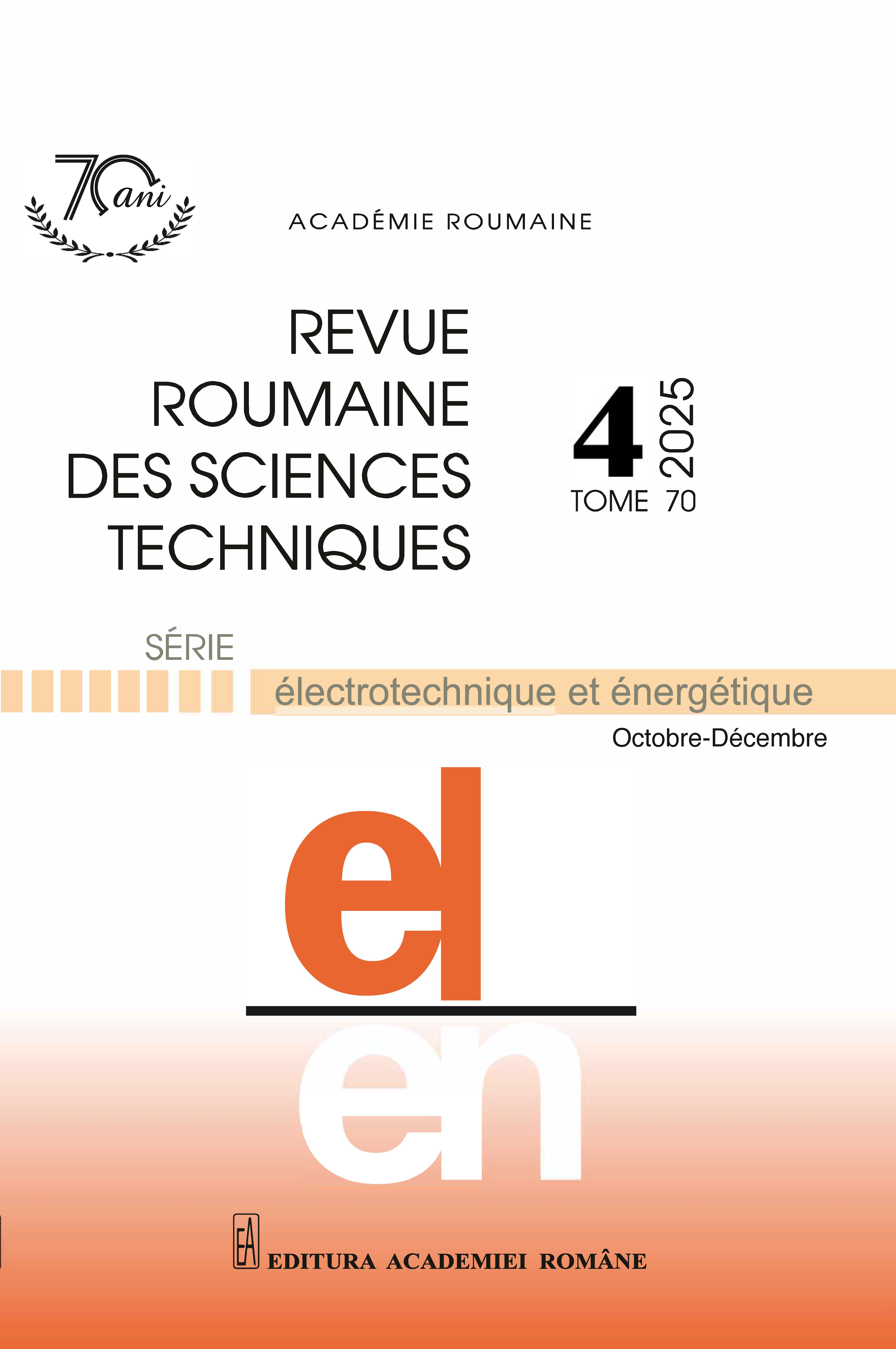EFFET DE LA GÉOMÉTRIE DES DÉFAUTS DANS UN COMPOSITE SUR LA FIABILITÉ
DOI :
https://doi.org/10.59277/RRST-EE.2025.4.7Mots-clés :
Géométrie et propriétés aléatoires, Composite, Contrôle non destructif, Éléments finis stochastiques, Analyse de fiabilitéRésumé
Ce travail porte sur l'étude de l'effet des propriétés physiques d'un matériau composite de type aléatoire et de la géométrie des défauts sur l'analyse de fiabilité d'un dispositif d'inspection utilisant des essais non destructifs. Deux types de géométries de défauts sont pris en compte : rectangulaires et triangulaires. Une méthode stochastique par éléments finis (SFEM) a été utilisée pour résoudre l'équation électromagnétique 2D dans une structure cylindrique. Le capteur différentiel détecte le changement d'impédance dans la zone de défaut. Le signal est analysé et comparé pour les deux types de géométries. Le post-traitement est lancé afin d'évaluer la fiabilité de notre structure en déterminant l'indice de fiabilité et la probabilité de défaillance. Les résultats obtenus pour des formes rectangulaires et triangulaires aléatoires sont présentés, ainsi qu'une comparaison entre la méthode des éléments finis stochastiques et la méthode de Monte Carlo. Une bonne concordance est observée. Les résultats montrent que le modèle SFEM proposé offre un post-traitement en plus de l'analyse, contrairement à la méthode de Monte Carlo, qui nécessite de nombreux tirages et s'appuie sur le problème inverse pour déterminer les valeurs réelles de la propriété physique considérée.
Références
(1) D. Kumar, R. Durgesh, C. Pruncu, Recent progress of reinforcement materials: a comprehensive overview of composite materials, J. Mater. Res. Technol., 8, 6, pp. 6354–6374 (2019).
(2) D. Kumar, S.D. Abdul Kalam, Design, analysis, and comparison between the conventional materials with composite material of the leaf, springs, Fluid Mech. Open Access, 3, pp. 127 (2016).
(3) J. Wen, Y. Zeng, C. Wu, J. Guan, H. Guo, Silk lattice structures from unidirectional silk fiber–reinforced composites for breaking energy absorption, Adv. Eng. Mater, 22, pp. 190092 (2020).
(4) D. Ragul, V. Thiyagrajan, A novel fault-tolerant asymmetrical 21-level inverter topology with reduced components, Rev. Roum. Sci. Techn. – Électrotechn. et Énerg., 68, 2, pp. 200–205 (2023).
(5) H.K. Bui, G. Wasselynck, D. Trichet, G. Berthiau, Application of degenerated hexahedral Whitney elements in the modeling of NDT induction thermography of laminated CFRP composite, IEEE Trans. Magn., 52, 3 (2016).
(6) M. Bowkett, K. Thanapalan, Comparative analysis of failure detection methods of composite materials, systems, Syst. Sci. Control Eng., 5, pp. 168–177 (2017).
(7) K. Guerraiche, A.B. Abbou, L. Dekhici, Intelligent fault detection and location in electrical high-voltage transmission lines, Rev. Roum. Sci. Techn. – Série Électrotechn. et Énerg., 69, 3, pp. 269–276 (2024).
(8) Z. Oudni, A. Berkache, H. Mehaddene, H. Mohellebi, J. Lee, Comparative study to assess reliability in the presence of two geometric defect shapes for non-destructive testing, Przegląd Elektrotechniczny, 95, 12, pp. 48–52 (2019).
(9) J. García-Martín, J. Gómez-Gil, E. Vázquez-Sánchez, Non-destructive techniques based on eddy current testing, Sensors, 11, pp. 2525–2565 (2011).
(10) G. Wasselynck, D. Trichet, J. Fouladgar, Determination of the electrical conductivity tensor of a CFRP composite using a 3-D percolation model, IEEE Trans. Magn., 49, 5 (2013).
(11) D. Hachi, N. Benhadda, B. Helifa, I.K. Lefkaier, B. Abdelhadi, Composite material characterization using eddy current by 3D FEM associated with iterative technique, Adv. Electromagn., 8, 1 (2019).
(12) T. Takagi, M. Hashimoto, H. Fukutomi, K. Miya, H. Tsuboi, M. Tanaka, J. Tani, T. Serizawa, Y. Harada, E. Okano, R. Murakami, Benchmark models of eddy current testing for steam generator tube: experiment and numerical analysis, Int. J. Appl. Electromagn. Mater., 5, pp. 149–162 (1994).
(13) Z. Oudni, M. Féliachi, H. Mohellebi, Assessment of the probability of failure for EC nondestructive testing based on intrusive spectral stochastic finite element method, Eur. Phys. J. Appl. Phys., 66, 3, pp. 30904 (2014).
(14) Z. Oudni, T. Mahmoudi, Exploitation of the spectral stochastic finite element model for the evaluation of surface defects of the CFRP composite, Prog. Electromagn. Res. M., 127, pp. 75–83 (2024).
(15) T. Mahmoudi, Z. Oudni, A. Berkache, J. Lee, Characterization of defects in composite materials by the intrusive stochastic method using the Gaussian type random variable, Przegląd Elektrotechniczny, 99, 3, pp. 246 (2023).
(16) S. Makkapati, S. Ramalingam, Lifetime prediction of single-stage LED driver circuit using Bayesian belief network, Rev. Roum. Sci. Techn. – Électrotechn. Et Énerg., 68, 4, pp. 351–356 (2023).
(17) B. Ponnuswamy, C. Columbus, S.R. Lakshmi, J. Chithambaram, Wind turbine fault modeling and classification using cuckoo-optimized modular neural networks, Rev. Roum. Sci. Techn. – Électrotechn. Et Énerg., 68, 4, pp. 369–374 (2023).
(18) M. Khebbab, M. Feliachi, E.H. Latreche, Application of finite elements heterogeneous multi-scale method to eddy currents non-destructive testing of carbon composite material, Eur. Phys. J. Appl. Phys., 80, pp. 10401 (2018).
(19) Y. Mizutani, A. Todoroki, Y. Suzuki, K. Mizukami, Detection of in-plane and out-of-plane fiber waviness in unidirectional carbon fiber reinforced composites using eddy current testing, Composites Part B, 86, pp. 84–94 (2016).
(20) M. Berveiller, B. Sudret, M. Lemaire, Stochastic finite element: a non-intrusive approach by regression, Eur. J. Comput. Mech., 15, 1-2-3, pp. 81–92 (2006).
(21) A. Efremov, O. Karpenko, L. Udpa, Generalized multifrequency fusion algorithm for defect detection in eddy current inspection data, NDT & E Int., 129, 3, pp. 102654 (2022).
(22) S. Pranesh, D. Ghosh, A FETI-DP-based parallel hybrid stochastic finite element method for large stochastic systems, Comput. Struct., 195 (2018).
(23) M. Loeve, Probability theory I, Springer-Verlag Inc. (1977).
(24) C.R.A. Da Silva Jr., A.T. Beck, E. Da Rosa, Solution of the stochastic beam bending problem by Galerkin method and the Askey-Wiener scheme, Latin Am. J. Solids Struct., 6, pp. 51–72 (2009).
Téléchargements
Publiée
Numéro
Rubrique
Licence
(c) Copyright REVUE ROUMAINE DES SCIENCES TECHNIQUES — SÉRIE ÉLECTROTECHNIQUE ET ÉNERGÉTIQUE 2025

Ce travail est disponible sous licence Creative Commons Attribution - Pas d'Utilisation Commerciale - Pas de Modification 4.0 International.


